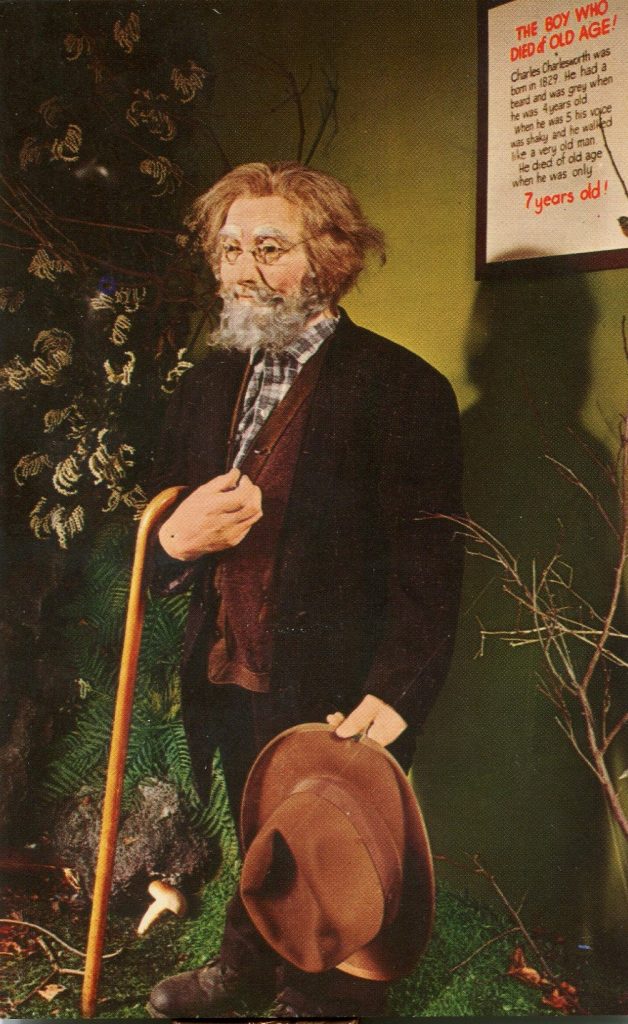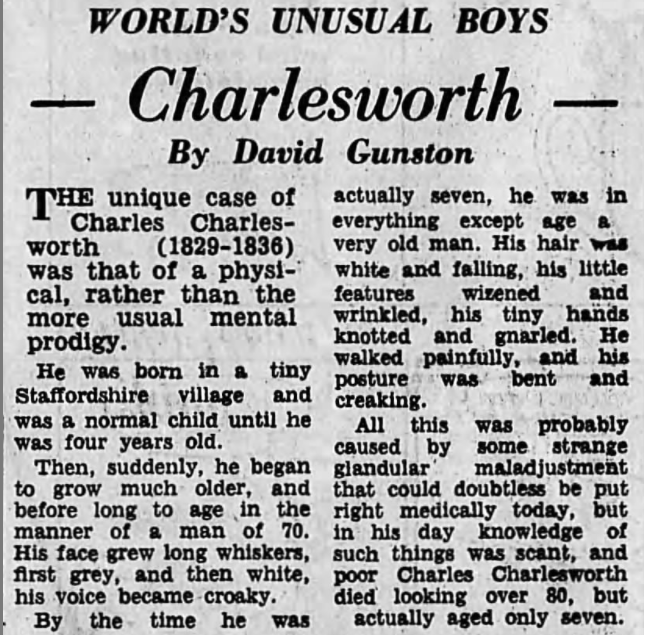Editor’s Staff
Charles Charlesworth
ATTENTION All Readers
The postcard below that suggested this Postcard History lesson is a
Curteich natural color chrome. Its production number is 9DK-698 (1969).
The following was prepared using information found at the
Mayo Foundation for Medical Education and Research
website and newspaper accounts.
Please – do not consider this medical advice.

Charles Charlesworth died at age seven from a “faint” or syncope. Syncope is a short-term loss of consciousness caused by a sudden drop in blood pressure. Such physiological events are extremely rare, but this one was brought about because young Charlesworth was afflicted with one of the most unusual conditions known to medical science – Progoria.

It would, without question be insensitive to do such reporting today considering privacy and the social convention of respecting an individual, but 1966 was more than fifty years ago and the historical revisionists had not yet organized.
If you read the above the reporter states that Charles Charlesworth was unique. The implication of the word “unique” is one-of-a-kind. Charlesworth was not unique, but the physical abnormality that killed him is rare.
The condition that came to be known as Hutchinson-Gilford Progeria Syndrome was first named circa 1897 – over sixty years after the death of Charles Charlesworth. It is a genetic condition that affects 1 in 4,000,000 births. A baby born with H-G PS appears normal at birth, but they grow slower than others and fail to gain weight at normal rates (in the science of gerontology this is known as failure to thrive).
Hutchinson-Gilford Progeria Syndrome also causes changes in hair color, hair loss, and joint problems. It also causes the subcutaneous fat to dissolve leaving the skin wrinkled and lacy. Surprisingly H-G PS does not affect brain function or motor skills.
* * *
Charles Charlesworth (1829-1836) was born of normal parents in a small village near Staffordshire, in the west midlands of England. In the 1830s, there was absolutely no understanding within medical science what cause Charles to grow whiskers at age four. Only one report exists concerning the Charlesworth case. It is not detailed but does state that he was small and disproportioned with respect to the width of his chest, lower jaw, part of his skull, and hands. Also, that his walk was unstable and his posture that of an old man.
* * *
Jonathan Hutchinson was first to study and describe progeria in 1886 and by Hastings Gilford shortly afterward in 1897. It is now known and understood; however progeria falls into a category of ailments known as orphan diseases. (An orphan disease is defined as a condition that affects fewer than 200,000 people nationwide. It is suspected that there are only 170,000 cases worldwide.) There is no cure, but early 21st century research has identified the DNA defect that causes the condition.
Here in America the first suspected case, which is still unverified, occurred in Toledo, Ohio, when school officials refused admittance to a six-year-old boy named Clarence Kehr. The case was widely documented in September 1930. Both public and Catholic school officials thought it inappropriate to put the boy, who wore a mustache, in classes with others his age.
* * *
The postcard above was produced by the Chicago branch of the Ripley Believe It or Not museum chain. The caption, in part, reads: Boy who died of old age recreated from Ripley Cartoons. The incredible Charles Charlesworth who lived only seven years, yet Died of Old Age.
I devoured the Ripley’s “Believe It or Not!” books when I was a kid, and even had a couple of T-shirts which reproduced selected cartoons from the feature.